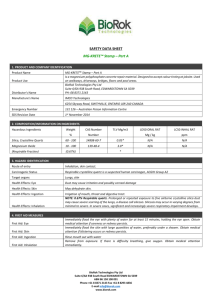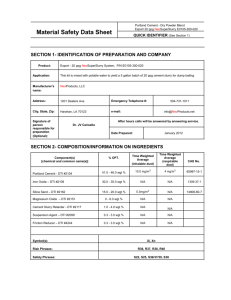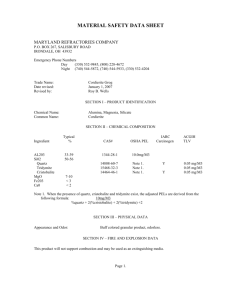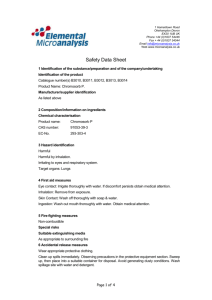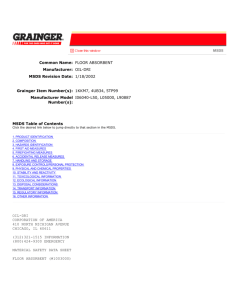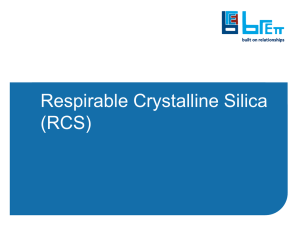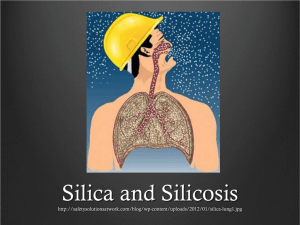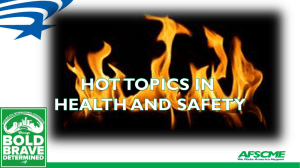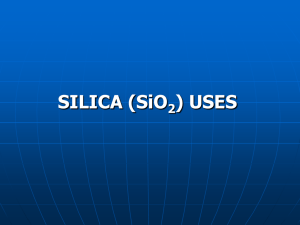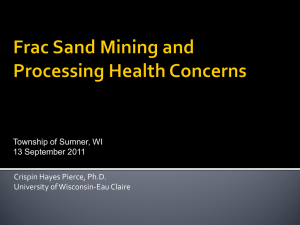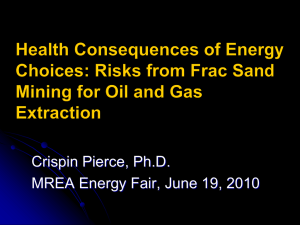Dry Powder Blend 20 ppg NeoSuperSlurry P/N 0105
advertisement
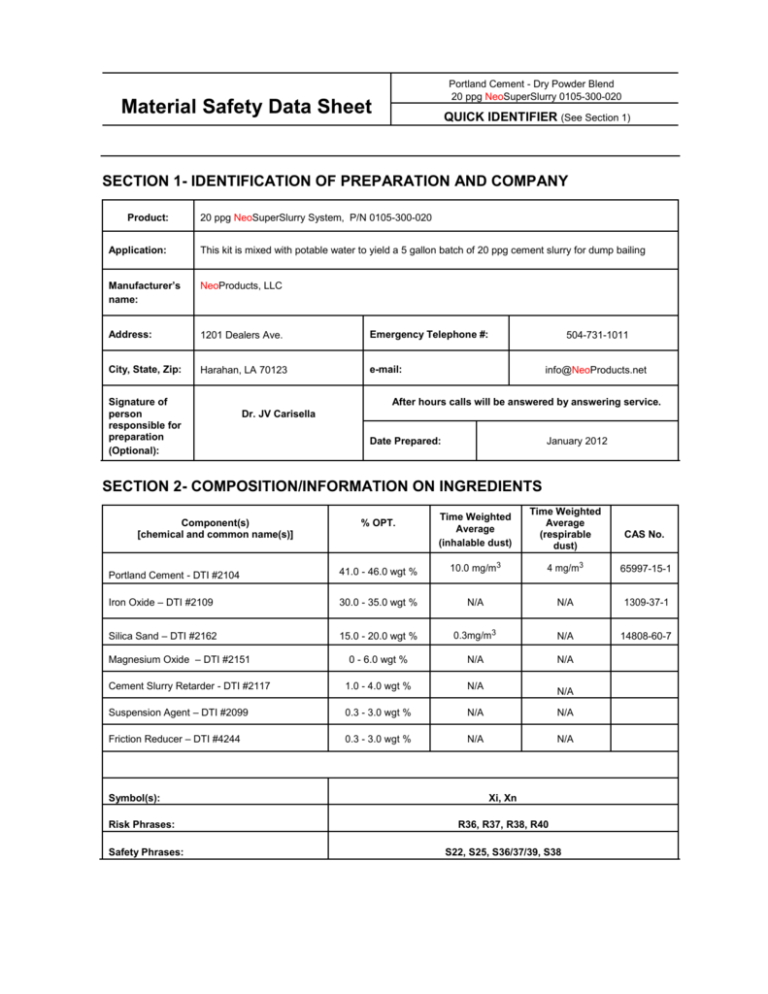
Portland Cement - Dry Powder Blend 20 ppg NeoSuperSlurry 0105-300-020 Material Safety Data Sheet QUICK IDENTIFIER (See Section 1) SECTION 1- IDENTIFICATION OF PREPARATION AND COMPANY Product: 20 ppg NeoSuperSlurry System, P/N 0105-300-020 Application: This kit is mixed with potable water to yield a 5 gallon batch of 20 ppg cement slurry for dump bailing Manufacturer’s name: NeoProducts, LLC Address: 1201 Dealers Ave. Emergency Telephone #: City, State, Zip: Harahan, LA 70123 e-mail: Signature of person responsible for preparation (Optional): 504-731-1011 info@NeoProducts.net After hours calls will be answered by answering service. Dr. JV Carisella Date Prepared: January 2012 SECTION 2- COMPOSITION/INFORMATION ON INGREDIENTS Component(s) [chemical and common name(s)] % OPT. Time Weighted Average (inhalable dust) Time Weighted Average (respirable dust) CAS No. Portland Cement - DTI #2104 41.0 - 46.0 wgt % 10.0 mg/m3 4 mg/m3 65997-15-1 Iron Oxide – DTI #2109 30.0 - 35.0 wgt % N/A N/A 1309-37-1 Silica Sand – DTI #2162 15.0 - 20.0 wgt % 0.3mg/m3 N/A 14808-60-7 0 - 6.0 wgt % N/A N/A Cement Slurry Retarder - DTI #2117 1.0 - 4.0 wgt % N/A Suspension Agent – DTI #2099 0.3 - 3.0 wgt % N/A N/A Friction Reducer – DTI #4244 0.3 - 3.0 wgt % N/A N/A Magnesium Oxide – DTI #2151 Symbol(s): Risk Phrases: Safety Phrases: N/A Xi, Xn R36, R37, R38, R40 S22, S25, S36/37/39, S38 SECTION 3- HAZARD IDENTIFICATION Fire: This preparation is not flammable. Health: Potentially hazardous during normal handling and use as instructed. Environment: No known hazards. Other Hazards: CAUTION! – ACUTE HEALTH HAZZARD This dry powder blend contains crystalline silica and quartz. May cause eye and respiratory irritation. DANGER! – CHRONIC HEALTH HAZZARD This dry powder blend contains crystalline silica and quartz. Breathing crystalline silica can cause lung disease including silicosis and lung cancer. Crystalline silica has also been associated with scleroderma and kidney disease. This product contains quartz, cristobalite, and/or tridymite, which may become airborne without a visible cloud. Use only with adequate ventilation to keep exposures below recommended exposure limits. Wear a NIOSH certified, European Standard EN 149 or equivalent respirator when using this product. Review the Material Safety Data Sheet (MSDS) for this product, which has been provided to your employer. SECTION 4- FIRST AID MEASURES Inhalation: This dry powder blend contains crystalline silica and quartz. If inhaled, remove from area to fresh air. Get medical attention if respiratory irritation develops or if breathing becomes difficult. Ingestion: First aid procedures are not required. Skin: Wash with soap and water. Eyes: Flush with plenty of water for at least 15 minutes. SECTION 5- FIRE FIGHTING MEASURES Extinguishing media: Product does not burn. Special fire fighting precautions: None. Product does not burn. Unusual fire and explosion hazards: No fire hazards. SECTION 6- ACCIDENTAL RELEASE MEASURES Personal precautions: Wear dust/mist respirator, work gloves and dust proof goggles. Environmental: No environmental hazards reported. Spillage: Use protective equipment, avoid creating or inhaling dust, sweep up and attempt to reuse product if not contaminated. Prevent entry into drains, sewers and watercourses. SECTION 7- HANDLING AND STORAGE This product contains quartz, cristobalite, and/or tridymite, which may become airborne without a visible cloud. Avoid breathing dust. Use only with adequate ventilation to keep exposures below recommended exposure limits. Wear a NIOSH certified, European Standard EN 149 or equivalent respirator when using this product. Material is slippery when wet. SECTION 8- EXPOSURE CONTROLS/ PERSONAL PROTECTION Engineering controls: Use in well ventilated area. Respiratory protection: Use approved dust/mist respirator. Hand protection: Use normal work gloves. Skin protection: Normal work coveralls. Eye protection: Use dust proof goggles. SECTION 9- PHYSICAL AND CHEMICAL PROPERTIES Physical State: Solid Vapor Density (Air=1): Not Determined Flash Point: Not Determined Color: Odor: Gray Solubility in Water (g/100ml): 0.5 PH: Odorless Vapor Pressure (mm HG): Not Determined LEL Lower: LEL Upper: N/A N/A Reactivity in Water: Not Determined Specific Gravity @ 20C (H2O=1): 3.15 Melting Point: N/A N/A Flammable Limits in Air% by Volume: Not Determined Boiling Point: Not Determined SECTION 10- STABILITY AND REACTIVITY Stability Data: Stable Hazardous Polymerization: Will not occur Conditions to avoid: Avoid contact with water Incompatibility (Materials to avoid): None known Hazardous Decomposition or Byproducts: None known SECTION 11- TOXICOLOGICAL INFORMATION Principle route of exposure: Eye or Skin contact, Inhalation. Inhalation: This dry powder blend contains crystalline silica and quartz. Inhaled crystalline silica in the form of quartz or cristobalite from occupational sources is carcinogenic to humans (IARC, Group 1). There is sufficient evidence in experimental animals for the carcinogenicity of tridymite (IARC, Group 2A). This dry powder blend contains crystalline silica and quartz. Breathing silica dust may cause irritation of the nose, throat and respiratory passages. Breathing silica may cause noticeable injury or illness even through permanent lung damage may be occurring. Inhalation of dust may also have serious chronic health effects (See “Chronic Effects / Carcinogenicity” subsection below). Skin Contact: Wet cement can dry skin and cause Alkali burns. Eye Contact: Dust can irritate eyes. Ingestion: No harmful affects known. Medical conditions aggravated by exposure: Chronic effects/ Carcinogenicity: Dermatitis Silicosis: Excessive inhalation of respirable crystalline silica dust may cause a progressive, disabling and sometime-fatal lung disease called silicosis. Symptoms include cough, shortened of breath, wheezing, nonspecific chest illness, and reduced pulmonary function. This disease is exacerbated by smoking. Individuals will silicosis are predisposed to develop tuberculosis. Cancer Status: The International Agency for Research on Cancer (IARC) has determined that crystalline silica inhaled in the form of quartz or crystallite from occupational sources can cause lung cancer in humans (Group 1 – carcinogenic to humans) and has determined that there is sufficient evidence in experimental animals for the carcinogenicity of tridymite (Group 2A – possible carcinogen to humans). Refer to IARC Monograph 68, Silica, Some Silicates and Organic Fibers (June 1997) in conjunction with the use of these minerals. The National Toxicology Program classifies respirable crystalline silica as “Known to be a human carcinogen”. Refer to the 9th Report of Carcinogens (2000). The American Conference of Governmental Industrial Hygienists (ACGIH) classifies crystalline silica, quartz, as a suspected human carcinogen (A2). There is some evidence that breathing respirable crystalline silica or the disease silicosis is associated with an increased incidence of significant endpoints such as acleroderma (an immune system disorder manifested by scarring of the lungs, skin, and other internal organs) and kidney disease. Other Information Toxicity Tests/ Carcinogenicity: This dry powder blend contains quartz, crystalline, silica and quartz. For further information consult “Adverse Effects of Crystalline Silica Exposure” published by the American Journal of Respiratory and Critical Care Medicine, Volume 155, pages 71-768 (1997). This dry powder blend contains quartz, crystalline, silica and quartz. Refer to IARC Monograph 68, Silica, Some Silicates and Organic Fibers (June 1997). SECTION 12- ECOLOGICAL INFORMATION Mobility (water/air/soil): Not Determined Persistence/ Degradability: Not Applicable Bio-Accumulation: Not Determined Aquatic Toxicity: Not Determined SECTION 13- DISPOSAL CONSIDERATIONS Disposal Method: Bury in a licensed landfill according to local regulations. Contaminated Packaging: Follow all applicable national or local regulations. SECTION 14- TRANSPORT INFORMATION NO SPECIAL PRECAUTIONS NECESSARY SECTION 15- REGULATORY INFORMATION Hazardous Ingredients: None Symbol(s): Xi , Xn Risk Phrases: R36 Irritating to eyes. R37 Irritating to Respiratory System. R38 Irritating to Skin. R49 May cause cancer by inhalation. Safety Phrases: S22 Do not breathe dust. S25 Avoid contact with eyes. S36/37/39 Wear suitable protective respiratory equipment, clothing, gloves, and eye/face protection. SECTION 16- ADDITIONAL INFORMATION: This product is intended for the stated application only. Do not use this product for any other applications without first obtaining guidance from an approved NeoProducts representative, beforehand. If this product is for resale, make sure the purchaser receives a copy of this safety data sheet upon acceptance of this preparation. Make sure the employees of your company are aware of the hazards, both chronic and acute, before allowing them to use this product. The information contained in this Material Safety Data Sheet is believed to be correct and reflects our best professional judgment. Because it is impossible to anticipate every condition under which this product will be used, this Material Safety Data Sheet shall only be used as a guide. It is imperative that each user of this product determines its suitability for his particular application and comply with all environmental and workplace regulations. Disclaimer Statement: This information is furnished without warranty, expressed or implied, as to accuracy or completeness. The information is obtained from various sources including the manufacturer and other third party sources. The information may not be valid under all conditions nor if this material is used in combination with other materials or in any process. Final determination of suitability of any material is the sole responsibility of the user.
